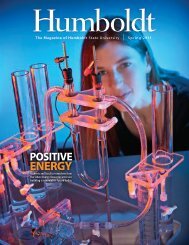Unveiled - Humboldt Magazine - Humboldt State University
Unveiled - Humboldt Magazine - Humboldt State University
Unveiled - Humboldt Magazine - Humboldt State University
You also want an ePaper? Increase the reach of your titles
YUMPU automatically turns print PDFs into web optimized ePapers that Google loves.
A NEW STUDY BY two <strong>Humboldt</strong> <strong>State</strong> professors and their<br />
students offers ways to literally look at the problems – and<br />
some approaches for addressing them. “People, Places and<br />
Health: A Sociospatial Perspective of Agricultural Workers<br />
and their Environment” is the work of Professors Sheila<br />
Lakshmi Steinberg and Steven J. Steinberg. Funded by the<br />
California Endowment, it maps pesticide use and its proximity<br />
to sensitive facilities like schools and playgrounds in six<br />
California communities.<br />
Sheila Steinberg, a sociology professor, is director of<br />
community research for HSU’s California Center for Rural<br />
Policy. Steve Steinberg, a professor in the Natural Resource<br />
Planning program, is director of the Institute for Spatial<br />
Analysis. To map pesticide use and dispersal, the husbandwife<br />
team fused her expertise in sociological field research<br />
with his acumen in geographic information systems (GIS).<br />
The resulting study has jumpstarted change on the ground<br />
where the chemicals are sprayed.<br />
Real people, real maladies<br />
TULARE AND MONTEREY COUNTIES are the secondand<br />
fourth-biggest agricultural counties in California,<br />
together accounting for $7 billion in agricultural value in<br />
2005. The counties employ a proportionate share of the state’s<br />
nearly 900,000 farmworkers and absorb a like proportion<br />
of pesticides – with nearly 200 million pounds applied in<br />
the year 2000.<br />
Health risks associated with pesticide exposure are known<br />
but not well understood. Health anomalies can include flulike<br />
illness, nervous disorders and cancer, with lingering<br />
suspicion that pesticides may be a factor. When spraying<br />
occurs, notification by local authorities is discretionary and<br />
inconsistent. And that lack of communication goes both<br />
ways. Cultural isolation fosters a sense of detachment among<br />
farmworkers from the processes intended to protect them.<br />
Like any other people, work, family and hope for the<br />
future consume the daily lives of California farmworkers.<br />
“These families are really interested in the education of their<br />
children,” says Alma Martinez, a reporter with Fresno-based<br />
Radio Bilingue. “They come to this country and what they<br />
want is their children to do better than they did, to advance<br />
academically and have a career.”<br />
PHOTOS COURTESY OF STEVE STEINBERG<br />
Digital divide<br />
JUST WHAT CHEMICALS ARE applied where The numbers<br />
available through the state’s Department of Pesticide<br />
Regulation (DPR) aren’t all that helpful. “There’s a huge digital<br />
divide,” says Sheila. “They say it’s ‘public data,’ but the average<br />
person would have a hard time getting access to it.”<br />
It’s not for lack of organization. Advocacy groups are active<br />
in the region, and communication lines are well established<br />
between activists and laborers. In fact, the Steinbergs chose<br />
16<br />
HUMBOLDT MAGAZINE | FALL 2009




